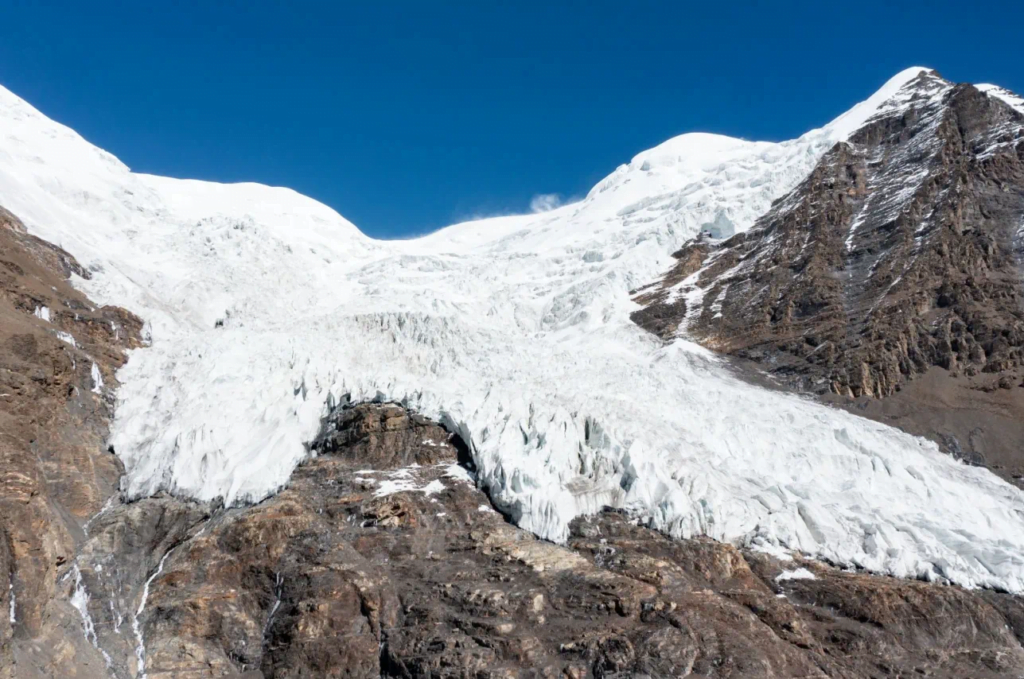Lhoka (Shannan), the cradle of Tibetan civilization, is home to some of the most sacred and awe-inspiring mountains in Tibet. These revered peaks not only boast breathtaking landscapes but also hold deep spiritual and historical significance. Among them, Gongbu Ri, Yarlha Shampo, and Wodé Gunggyel stand out as legendary mountains that continue to attract pilgrims, adventurers, and researchers alike. These peaks are not only natural wonders but also hold deep religious and cultural significance in Tibetan Buddhism.
Gongbu Ri: The Sacred Mountain of Omniscience
Located in the Nedong District, on the southern side of the Yarlung Tsangpo River near Tsetang Town, Gongbu Ri is one of Tibet’s most renowned sacred mountains. According to Tibetan mythology, reaching the summit of this mountain grants one omniscient knowledge. Gongbu Ri features three interconnected peaks:
- Yangga Uzi
- Senmu Uzi
- Dukang Zi
Legends state that the first ancestors of the Tibetan people—the Monkey King and the Rakshasa woman—resided on Senmu Uzi and Yangga Uzi. Under the guidance of Samantabhadra Bodhisattva, they were united in marriage, giving rise to the Tibetan people. Drukang Zi, the third peak, served as a sacred meditation site for Samantabhadra.
The vast plain in front of Gongbu Ri is believed to have been the playground of the monkey tribes, leading to the name “Tsetang.” Today, the region is home to numerous historic monasteries and sacred caves, making it a must-visit destination for spiritual seekers.
Yarlha Shampo: The Supreme Mountain Deity of Tibet
Standing majestically at the source of the Yarlung River in Nedong District, Yarlha Shampo (སྲིད་པའི་ལྷ་ཆེན་ཡར་ལྷ་ཤམ་པོ།) is revered as the supreme mountain deity of Tibet’s ancient tribes. As the second-ranking deity among the Nine Gods of World Formation, he is often referred to as the “Great God of Sipa.”
In Tibetan mythology, Yarlha Shampo manifests as a white yak, continuously spewing snow from his mouth and nostrils. His divine power is immense—capable of shattering rocks, triggering floods, and transforming into a white-skinned human to marry and bear children with mortals. Tibetan paintings depict Yarlha Shampo as a deity with a conch-white body, dressed in flowing white robes, wielding a short spear and a crystal sword. His consort, Langmyan Tokyip Yu, leads the celestial goddesses.
Originally a Bon deity who opposed Buddhism, Yarlha Shampo was later subdued by Guru Padmasambhava, becoming a Buddhist protector deity. Today, pilgrims flock to this sacred mountain, seeking divine blessings and enlightenment.
Wodé Gunggyel: The Father of Sacred Tibetan Mountains
Located in Sangri County, on the northern bank of the Yarlung Tsangpo River, Wodé Gunggyel is regarded as the father of Nyenchen Tanglha, Yarlha Shampo, Amnye Machen, and other eight sacred mountains. Together, they form the “Nine Gods of World Formation.”
Wodé Gunggyel (སྲིད་པའི་ལྷ་ཆེན་འོ་དེ་གུང་རྒྱལ།) is traditionally depicted as a powerful deity wearing a silk headscarf and cloak, adorned with turquoise bracelets, wielding a long spear and riding a mighty steed. His consort, Yünqia Xiuji, is also venerated in Tibetan culture.
This mountain plays a crucial role in shaping the landscape of Shannan. Due to the immense pressure exerted by Wodé Gunggyel Mountain, the Yarlung Tsangpo River has carved a deep gorge, stretching for kilometers. This dramatic terrain features towering cliffs, jagged rock formations, and roaring waterfalls, creating one of Tibet’s most breathtaking natural wonders.
At the base of Wodé Gunggyel, ancient Buddhist fortresses, meditation caves, and monasteries stand as testaments to Tibet’s rich spiritual heritage. Additionally, the Woka Power Plant, the largest hydroelectric station in Shannan, harnesses the energy of this mighty river, showcasing a blend of tradition and modernity.
Chuguo Ri – The Source of Happiness in Tibet
Nestled in Gonggar County, on the southern bank of the Qushui Bridge, Chuguo Ri is one of the Four Great Sacred Mountains of Tibetan Buddhism. Revered as the “Source of Happiness in Tibet”, this mountain is surrounded by fertile farmland and vast natural pastures.
Local farmers cultivate barley, wheat, and rapeseed, while herders tend to yaks, sheep, and goats, creating a picturesque landscape that blends spirituality with the rhythms of rural Tibetan life. Pilgrims and travelers visiting Chuguo Ri can immerse themselves in the profound serenity of this sacred land.
Kula Gangri – The Sacred Abode of King Gesar
Rising majestically in Lhozhag County, Kula Kangri stands at an impressive 7,538 meters, making it one of Tibet’s 44 officially open peaks. This mountain is deeply embedded in Tibetan mythology, being one of the Four Great Mountain Gods of Tibet.
According to ancient legends, Kula Kangri embodies the spirit of King Gesar, the heroic warrior-king of Tibetan folklore. It is believed that he resides in a celestial palace made of gemstones and crystals, known as “Kanyen Gurlha Hari“
In Tibetan Buddhist art, Kurla Kangri is depicted as a powerful male deity dressed in white robes, wearing a helmet and crystal armor. He holds a short spear in his right hand and a wolf skull in his left, riding a flying white horse. His consort, Jam Sisa, is adorned with precious jewels and rides a deer.
The mountain is also home to Guru Padmasambhava’s meditation caves, located in four sacred directions:
- East: Zhutsok Pema Ling
- South: Jikhuo Thang
- West: Guo’o Pu
- North: Tsoje Zaji
These meditation sites enhance Kula Kangri’s reputation as a profoundly sacred pilgrimage destination.
Haiburi Sacred Mountain – The Protector of Samye Monastery
Located in Zhanang County, east of Samye Monastery, Haiburi Sacred Mountain holds a pivotal place in Tibetan Buddhist history. According to legend, during the construction of Samye Monastery, demons attempted to obstruct its progress. Guru Padmasambhava subdued these malevolent forces on Haiburi Mountain using a giant rock, ensuring the monastery’s completion.
Today, this sacred mountain remains a site of spiritual reverence, surrounded by lush pastures and farmland. Visitors can explore the tranquil beauty of the region while delving into its legendary past.
Kanggeduo Peak – The Snow-Crowned Jewel of Tibet
Situated in Cuona County, Kanggeduo Peak soars to 7,060 meters, earning its place among Tibet’s 44 officially open peaks. The mountain is permanently blanketed in snow and ice, resembling a magnificent silver crown against the backdrop of the Tibetan sky.
The ever-changing play of floating white clouds and dazzling sunlight creates a mesmerizing visual spectacle, making Kanggeduo Peak a paradise for photographers, trekkers, and spiritual seekers. The mountain’s ethereal beauty evokes a sense of divine presence, drawing visitors into its mystical embrace.
Mystical Kari Holy Mountain
Nestled in Langkazi County and Renbu County, southwest of the stunning Yamdrok Lake, Kari Holy Mountain is a revered pilgrimage site in Tibet. Ancient texts describe it as “an immeasurable palace, with the surrounding forests as its courtiers.” The mountain’s peak, Dedong (Arrow Sheath), holds deep spiritual significance, as legend states that King Gesar once struck down a giant Garuda here with his bow.
Sacred Sites on Kari Holy Mountain
Tibetan historical records highlight several divine landmarks within the mountain:
- Domu Na Cave, Lunbu Cliff – Home to a naturally formed image of Guru Padmasambhava, one of the most venerated figures in Tibetan Buddhism.
- Southern Cliff Formation – A natural depiction of Buddha Mother, considered a sacred manifestation.
- Tara Lotus Cave – From this mystical cave, holy water flows, believed to wash away sins and bestow auspicious blessings upon those who drink or bathe in it.
The Grand Kari Yekor Pilgrimage
From the 15th day of the 4th lunar month to the 15th day of the 6th lunar month, thousands of Tibetan pilgrims from Langkazi, Renbu, Qushui, Nimu, Kham, and Amdo embark on the Kari Yekor pilgrimage. They circumambulate the summit, mid-section, and base of the holy mountain, creating a vibrant and deeply spiritual atmosphere filled with prayers and sacred rituals.
Jangsang Lhamo Peak: A Stunning Snow-Capped Wonder
Located in Langkazi County, Jangsang Lhamo Peak rises 6,324 meters above sea level, standing as one of Tibet’s 44 officially open peaks. This majestic mountain remains snow-covered year-round, offering breathtaking scenery.
The lower slopes of Jangsang Lhamo Peak feature lush pastures and farmlands, where locals cultivate barley, rapeseed, potatoes, and Rhodiola roots—a prized medicinal herb. Yaks, dzo (hybrid cattle), yellow cattle, sheep, and goats roam freely across these fertile lands, supporting traditional Tibetan nomadic culture.

Jietong Susong Peak: A High-Altitude Paradise
Standing at an impressive 7,060 meters, Jietong Susong Peak is a towering jewel in Nagartse County and one of Tibet’s officially designated climbing destinations. Its perpetual snow and vast glaciers create an awe-inspiring landscape.
This mountain is a sanctuary for rare Tibetan wildlife, including:
- Wild asses
- Snow leopards
- Blue sheep
- Tibetan gazelles
- Musk deer
- Lynxes
The region is also rich in valuable medicinal plants, such as cordyceps, fritillaria, snow lotus, ephedra, and gentian, making it a hotspot for traditional Tibetan medicine enthusiasts.

Nojin Gangsang Peak: A Legendary Snow Mountain
Also referred to as “Notjin Kansang La,” “Ningjing Kangsha,” or “Nojin Kangsang,” this 7,191-meter peak is steeped in spiritual and mountaineering history.
The name is believed to mean either:
- “The Mountain of Yaksha and Manjushri”
- “The High Noble Snow Mountain where Yaksha Resides”
Situated between Langkazi County and Gyangze County, Ningjingangsang Peak is covered in snow and glaciers all year round. Occasionally, avalanches occur due to its rugged terrain.
Climbing History
On April 28, 1986, the China Tibet Mountaineering Team successfully reached the summit via the southwest ridge route, marking a historic ascent.
Local Culture and Agriculture
The lower slopes of Ningjingangsang Peak are home to natural pastures and farmlands, where Tibetan communities engage in farming and yak herding, preserving their centuries-old way of life.
Plan Your Journey to Tibet’s Sacred Mountains
For adventurers, spiritual seekers, and mountain climbers, these sacred peaks in Tibet offer breathtaking landscapes, deep spiritual significance, and rich Tibetan cultural heritage. Whether you seek divine blessings at Kari Holy Mountain, explore the wildlife and medicinal plants of Jietong Susong Peak, or conquer Tibet’s mighty summits, these majestic mountains promise an unforgettable journey into the heart of the Himalayas.
Experience the Sacred Majesty of Tibet’s Holy Peaks
Tibet’s sacred mountains are more than just geographical wonders—they are spiritual sanctuaries that have inspired devotion for centuries. Whether you seek adventure, pilgrimage, or profound serenity, these mountains offer an unforgettable journey into the heart of Tibetan culture and Buddhism.
Why Visit the Sacred Mountains of Shannan?
For travelers, Tibet’s sacred mountains offer more than just stunning landscapes—they provide a deep spiritual experience and a glimpse into the heart of Tibetan mythology. Whether you are a pilgrim seeking divine blessings, a historian exploring ancient legends, or an adventurer drawn to Tibet’s untouched wilderness, Shannan’s mountains promise an unforgettable journey.
Key Attractions Near These Sacred Mountains:
- Samye Monastery – Tibet’s first Buddhist monastery, located near Yarlha Shampo.
- Trandruk Monastery – A significant spiritual site near Tsetang.
- Yumbulagang Palace – The first Tibetan palace, offering panoramic views of the Yarlung Valley.
Shannan’s sacred mountains are not just geographical landmarks; they are deeply woven into Tibetan spirituality, history, and culture. From the legendary origins of the Tibetan people at Gongbu Ri to the divine power of Yarlha Shampo and the awe-inspiring landscapes of Wodé Gunggyel, these mountains continue to inspire and captivate all who visit.
If you’re planning a Tibet tour, make sure to include these legendary peaks in your itinerary. Whether for cultural exploration, trekking, or spiritual pilgrimage, Shannan’s mountains offer an experience like no other.

